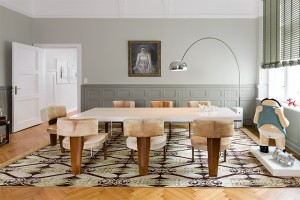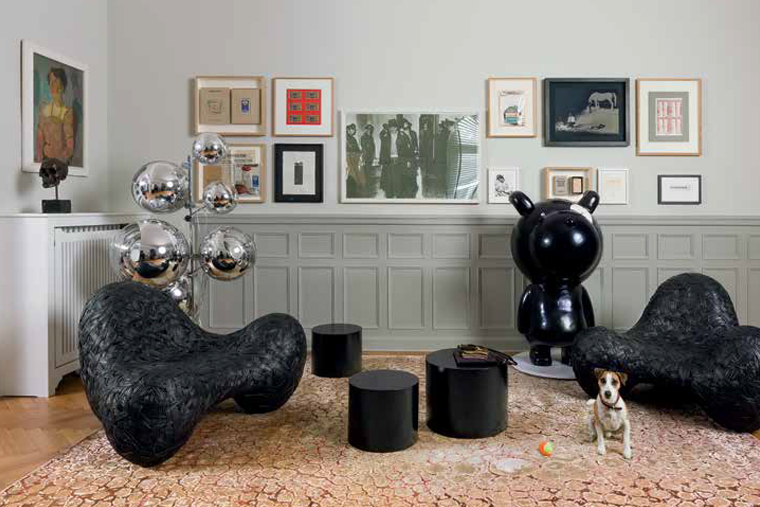 A designer’s passion for carpets becomes his life’s work
A designer’s passion for carpets becomes his life’s workBY SUZANNE WINTROB
Jürgen Dahlmanns has been captivated by fabrics since the day he was born.
“My mum said when I was a baby she’d forget to feed me because I was never screaming,” he says. “I was trying to get the little fibres out of the cloth. I was so fascinated by textiles and would stare at it for hours. Later on, I was eating the corner of my pillows or my pyjamas. I was always trying to get into the textile and deconstruct it. I felt really embraced by textiles. Then you grow up and forget that, and sooner or later you realize this is basically your identity. And you’re happy because what matches your character becomes your profession … if you’re lucky.”
Fast forward 48years and that curious baby now travels the world promoting his line of exquisite handmade Tibetan and Persian hand-knotted rugs, and overseeing the work of 2,000 people at six production facilities in Nepal and India. Dahlmanns’s contemporary designs sell in Rug Star stores in Germany, Switzerland and China and through numerous international retail partners, including Toronto’s Weavers Art and Modern Weave.
During Dahlmanns’s recent trip to Toronto, Weavers Art held a grand industry bash in his honour and transformed the showroom with 47 of his most intriguing pieces.
 Michael Pourvakil, owner and president of Weavers Art, became fascinated with the Rug Star line when he discovered them eight years ago. As one of the first Canadian companies to introduce contemporary carpets to the Toronto market, Pourvakil is always looking for artists who are trendsetters. When he met Dahlmanns, it was a perfect match.
Michael Pourvakil, owner and president of Weavers Art, became fascinated with the Rug Star line when he discovered them eight years ago. As one of the first Canadian companies to introduce contemporary carpets to the Toronto market, Pourvakil is always looking for artists who are trendsetters. When he met Dahlmanns, it was a perfect match.
“I’m a gambler by nature,” says Pourvakil. “I like to take chances and I don’t like to play things safe. We’ve always been one step ahead of other people. When I met Jürgen in Germany, I fell in love with his work. His range of development wasn’t anywhere as diverse and spectacular as it is today, but I saw something in his work that was different. It wasn’t safe. It’s an extension of his personality, which is a true artist.”
Get Dahlmanns talking and it’s clear that rugs aren’t purely a business for him; they’re his passion. The self-confessed “rug addict” plunked down $50 for his first Tibetan sleeping carpet (or khaden) while travelling through Nepal, only to discover once he returned to Berlin that it was worth about $6,000. This so intrigued the university student that he returned numerous times to scour for more great finds. Within eight years Dahlmanns had amassed a collection of 36 carpets and considered many of the Nepalese he knew like family.
It wasn’t surprising, then, that in 2001 he quit his job as an architect and went into rug design full-time, using his Asian connections to help him build a business. But first he had to persuade them to start making rugs as their ancestors did.
“I could not understand how a culture can have so much beauty by heritage but produce such ugly modern carpets,” says Dahlmanns. “I said, ‘Why are you dressed so beautifully; why are your homes so beautiful; why is your way of thinking so beautiful but the result of your work is so odd?’ They said, ‘That’s the way the Western people want it to be.’ I said, ‘That can’t be. In this product I am missing identity, I am missing intimacy, I am missing heritage. The old way of how to spin the wool and dye the wool got lost. A change of colour, which is unpredictable, gives beauty because it adds something to a piece, which is original.’ ”
 Today, Rug Star produces only hand-knotted carpets using fair-trade raw materials such as Chinese silk, Tibetan highland wool, Himalayan hemp and nettle fibre. The vast collection includes everything from nature and paint splotches to geometrics, guns, animals and even intricate Biblical scenes. They’re “naughty and smart,” he says, but all are crafted using century-old handmade combing, spinning and dying techniques that give each piece individual expression. It takes four to six people about five months (that’s 3,000 working hours) to make one carpet, with everyone committing to the same physical rhythm on the loom. The unity and harmony creates a truly high-end eight-by-10-foot carpet, priced from $12,000 to $20,000 depending on a pattern’s intricacy.
Today, Rug Star produces only hand-knotted carpets using fair-trade raw materials such as Chinese silk, Tibetan highland wool, Himalayan hemp and nettle fibre. The vast collection includes everything from nature and paint splotches to geometrics, guns, animals and even intricate Biblical scenes. They’re “naughty and smart,” he says, but all are crafted using century-old handmade combing, spinning and dying techniques that give each piece individual expression. It takes four to six people about five months (that’s 3,000 working hours) to make one carpet, with everyone committing to the same physical rhythm on the loom. The unity and harmony creates a truly high-end eight-by-10-foot carpet, priced from $12,000 to $20,000 depending on a pattern’s intricacy.
Dahlmanns has seen his rugs mounted on walls by musicians looking to vary acoustics. But most people place them on floors, of course, and for good reason. Rugs divide rooms without using walls, says Dahlmanns, and they make people feel connected to the space, or to each other, rather than to a door. His own bedroom is a perfect example, its silk carpet covering the hardwood floor to infuse intimacy.
“I go away from daily life into my most private dream state,” Dahlmanns says. “The carpet is a transit zone from reality into where I want to be embraced.”












